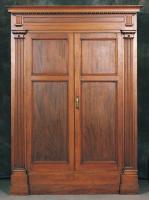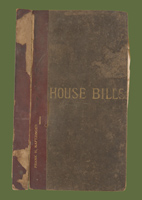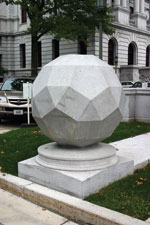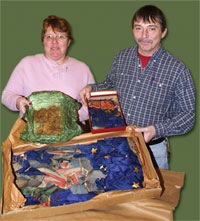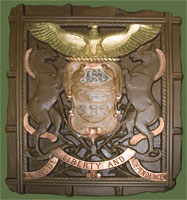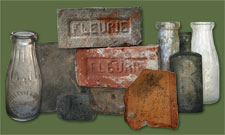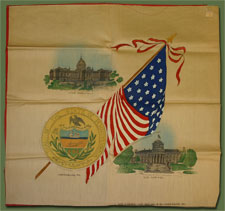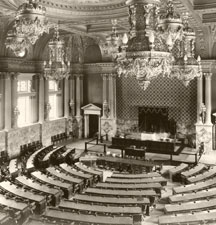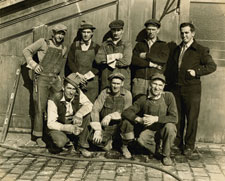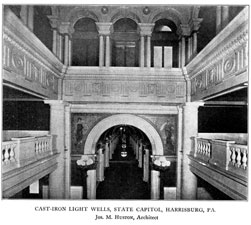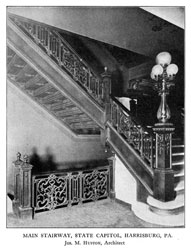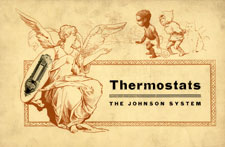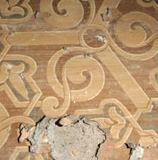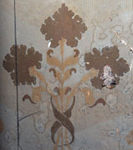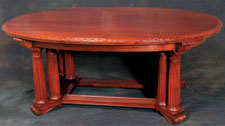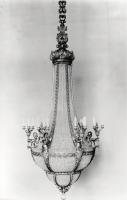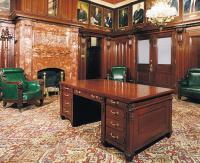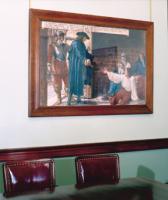Lost and Found Capitol TreasuresIn addition to the ongoing preservation work that is conducted throughout the Capitol building, one of the most rewarding challenges for the Capitol Preservation Committee is locating lost items or facts that relate to the history of this magnificent State treasure. Like most public buildings, the Capitol has seen countless changes over the many decades since its construction in 1906. As styles and tastes changed over the years prior to the formation of the Capitol Preservation Committee, original furnishings were often abandoned and/or replaced to match "modern" decor.
The majority of the original furnishings, which were custom designed by Capitol architect Joseph M. Huston, contained many features to match the architectural profiles of specific suites. For example, highly ornate chairs made from quarter-sawn oak with tooled leather seats and backs were exclusive to the Governor's Reception suite. All other rooms were supplied with mahogany furniture. Items such as coat trees, matching sofas and chairs, and wardrobes with beveled glass doors were all custom-designed and meticulously crafted specifically for the Capitol building. There are still many more Capitol treasures waiting to be found. You can help by sharing knowledge about other historic artifacts that may have originated from the Pennsylvania State Capitol by contacting the Committee. The important task of preserving and maintaining the history of the State Capitol is one that benefits all Pennsylvanians and generations to come. Click on a year below to view some of the Committee's notable discoveries. FOUND: Hill's Capitol Member's Desk
The committee was able to obtain an original 1822 Hill's Capitol House Chamber member's desk. The Hill's Capitol was the original building built in Harrisburg. Work was begun in 1819 and the building was finished and furnished by 1822, however by 1867-68 most all of the original furniture had been upgraded and was sold. Desks were again replaced after the new state constitution of 1877 enlarged the legislature. In 1897 the Hill's Capitol burned beyond repair and was razed. Several unique items such as artwork and settees survived, but most original furniture that remained was lost to the fire. Unlike later desks made for the Hill's Capitol, this unique original desk has a seat number listed on its front, so we are able to identify all the members who may have occupied this seat during the course of the nineteenth century�truly a unique piece of Capitol history. FOUND: House Bills, 1899 Session
The Capitol Preservation Committee recently acquired a historic bound copy of the House Bills of the 1899 session. Rep. Frank H. Naftzinger of Berks County originally owned this folio. The 1899-1901 sessions of the Pennsylvania State Legislature are unique because they were the only two to meet in the Cobb Capitol Building, which served as the interim Capitol until the current Joseph Huston-designed building was constructed. The bound folio of House bills numbers approximately 2900 pages and is eight inches thick, which is exceptionally interesting given the fact that the 1899 legislative session ranks as one of the shortest and least active in terms of the passing of laws in the history of the legislature. This acquisition will be placed in the newly constructed Rare Books Room in the Pennsylvania State Library and be available to patrons interested in researching the historical operations of the Pennsylvania State Legislature. FOUND: Historic Capitol Bench
The Committee was very fortunate to find a bench from the 1906 Capitol which was originally located in the House Anteroom. This bench can be seen in the original 1902 Special Furniture drawings that were produced by architect Joseph M. Huston. The bench is approximately 10 feet long and is upholstered on the seat, back, and sides. It has high sides without arms and was intended as a waiting bench for lobbyists, guests, and others waiting to conduct business or have discussions with Representatives before they went into official session on the floor. The historic Capitol bench will undergo restoration and be placed back in the Capitol. FOUND: Cherub Light Fixture
A surprising discovery was made by Ruthann Hubbert-Kemper on eBay when this wall sconce was detected immediately as one of only four originals made for the Governor's Private Office in the Capitol building. This exquisitely detailed cast bronze sconce is hand chased and was custom made by the Pennsylvania Bronze Company, located in Philadelphia. Once the committee made the purchase, the previous owner revealed that it had lain in a garage for many years and that it was acquired at a public sale in Harrisburg from a man who had worked for the state in the 1950's. In the decade following World War II the capitol underwent many renovations that included upgrades such as heating, air conditioning, and electrical. During this time frame many of the 1906 bronze light fixtures were removed and discarded, some were sold for scrap metal and others were part of the work designated for dispersal by contractors. This was a time when many suspended ceilings were installed so that ductwork could be hidden and florescent lighting could be added. In the governor's private office the two original chandeliers and four similarly-styled cherub sconces were taken down. The sconces were not replaced and the holes in the walls were fitted with a piece of wood. The cut crystal chandeliers were removed from the ceiling and the bottom sections with the cherubs and crystal were separated from the canopy. A contemporary "post office modern" styled fixture was attached to the existing 1906 canopy and chain, and re-hung at the existing location. These two fixtures are still in the room. The committee plans to use the rediscovered sconce to make a mold for replication of the lost fixtures, and to return the original to its historic location. LOST: Information About Capitol Rhombicosidodecahedrons
In addition to documenting the preservation aspects of a project, when the final report is compiled it often includes relevant background history, if known. In some cases, however, historic background information remains a mystery since documentation prior to the project commencing does not exist. As part of the plaza balustrade preservation project, the Committee performed preservation maintenance repairs to the pair of rhombicosidodecahedrons, which flank the north entrance to the upper parking deck of the Capitol building. Unfortunately, there is very little information about these enormous and unusual architectural elements to be found. Besides being a tongue twister, a rhombicosidodecahedron is a shape that has 20 regular triangular faces, 30 regular square faces, 12 regular pentagonal faces, 60 vertices, and 120 edges. The derivation of the three part name for the planar shapes, which make up the polyhedron "meaning many faces" come from the word rhombic meaning square or cube; isosahedron the equilateral triangle; and pentagon dodecahedron. Polyhedrons are usually named by the Greek word for the number of faces on the solid, plus the word hedron. Plato felt that creation involved sorting out pre-existing elements fire, air, earth, and water into coherent patterns. He identified fire with a tetrahedron, earth with the cube, air with the octahedron, and water with the icosahedron. The cosmos, Plato believed, was a dodecahedron that consumed everything. Knowing this, however, does not explain the significance or reason that rhombicosidodecahedrons were installed in Capitol Park in 1928. It is only known that architects William Gehron and Sydney Ross designed them in 1927. The Committee would appreciate learning further details about the Capitol's rhombicosidodecahedrons. If you have details about these, or other historic items, please contact the Capitol Preservation Committee. FOUND: Civil War Flag
Flags that are returned to the Capitol Preservation Committee usually have some quintessentially odd historical provenances attached to their extra 135 years of travel, like that of the Pennsylvania Bucktails or the 150th Volunteers. Each has stories that make their wartime and post-war service unique. The postwar history of the regimental color for the 11th Reserves (40th Infantry) is no different. This regimental (large Federal style eagle) flag was at one time owned by Francis A. Lord, noted author and collector of southern Civil War artifacts, who sold it to Mr. David Vernum-Holder, a native of Great Britain. The flag remained in England for numerous years until Steve Heller of Newport, PA, a collector of Civil War memorabilia, discovered it. Mr. Heller acquired the flag from Vernum-Holder and donated it to the Committee to ensure that the remnants will last for as long as possible. Prior to its ownership by Francis A. Lord, it is uncertain where the flag resided. The Committee is currently working with a textile conservator to conserve the pieces of the color. As the process is undertaken, the Committee hopes to discover more evidence of the flag's post-Civil War provenance. FOUND: Pennsylvania Coat of Arms
Joseph Konrad of Washington, D.C. contacted the Committee over the summer with an interesting discovery. He had acquired a 1930s plaster casting mold of the Pennsylvania Coat of Arms. The Committee was able to research and document this piece as being an original to the Forum Building, formerly known as the Education Building located in the Capitol Complex. Typically, these casts were kept in the attics of the buildings for which they were designed. This was a safeguard so that if the original ever became damaged, a replica could be made. Mr. Konrad bought the cast from a friend who had acquired it years ago in Philadelphia. Upon learning of its history, he offered to return it to its proper home for $300 the cost he originally paid. FOUND: 1876 House Members Framed Print
This framed print, a rather unusual find, shows each member of the House of Representatives from 1876. The bottom of the print reads, "Photograph by Le Rue Lemur Harrisburg, Pennsylvania." Previously the print belonged to Mrs. Bea Kistler of Cumberland County, who presented it to the Committee through Senator Patricia Vance. It had been in the Kistler family for generations because William Kistler served in the Legislature from 1874-1876 representing Carbon and Monroe counties. Another interesting fact is that this print was produced the same year as the nation's centennial. But more importantly, it contains photographs of the legislative members, which at this early date are very difficult to find. Unlike the Pennsylvania Manual of today that contains printed photographs of legislative members, the early version of this state printed document, Smull's Legislative Hand Book and Manual, contained only engravings of the State Capitol building, not photos of Assembly Members. This is a welcome addition to the Committee's collection, thanks to Mrs. Kistler and Senator Vance. FOUND: Capitol Club Chair
During a trip to an antique shop in Lemoyne, then-Committee Executive Director Ruthann Hubbert-Kemper immediately recognized this chair to be a historic 1906 Capitol club chair. Custom-designed by architect Joseph Huston, it is one of a series of specially made furniture that was ordered for the Capitol and placed in the "Heads of State" offices. It is made from mahogany with carved and turned elements and was originally covered in leather, although the upholstery was altered over the years. Long before the Committee was formed, many pieces of Capitol furniture were sent to State Surplus as decor was altered to fit changing tastes. The Committee plans to restore this historic piece and return it to an office in the Capitol. FOUND: Capitol Inaugural Pin
William Alexis Stone (1846-1920) was inaugurated as the Governor of Pennsylvania on January 17, 1899 and served until January 20, 1903. This historic pin depicts the winning competition design by architect Henry Ives Cobb for the construction of a new State Capitol in 1898. A disastrous fire had consumed the old Capitol designed by Steven Hills on February 2, 1897. In his message to the legislature when he took office in January 1901, Governor Stone recommended passing legislation for the purpose of building a State Capitol and expending money from the general revenues of the state. Stone, as President of the Capitol Building Commission, awarded a contract in 1902 to Joseph Huston to complete the Capitol that had been started by Cobb. Unfortunately Cobb's original design, depicted on this pin, was never completed. LOST: Table from Lieutenant Governor's Ladies Lounge
The round, marble-topped table shown on the left was originally placed in Room 203 the Ladies' Lounge. No longer used as a lounge, this room now serves an office for the Lieutenant Governor's staff. This historic photograph shows a view of this room taken after the Capitol's dedication in 1906. The ornate features of the table's mahogany base and legs are indicative of the custom furniture designed by Capitol architect Joseph Huston. Today, the whereabouts of the table remains a mystery. The Committee would appreciate learning about information on this table as we continue to document the Capitol's history. FOUND: Artifacts From Underneath Capitol's West Steps
Workers made some fascinating discoveries amidst the rubble underneath the Capitol's west steps during the project's excavation phase. Featured items: three milk bottles imprinted with "One pint liquid; Bellevue Dairy, Jos. A. Rudy, Paxtang, PA;" large chunks of granite, coal; and brownstone; clay bricks imprinted "FLEURIE," which were from the steps' original support piers; a chunk of clay brick showing a series of figures printed in pencil; a whiskey bottle imprinted "Pure all rye whisky, bottled expressly for family use, honest measure." FOUND: Capitol Pillowcase
William H. Thomas, local collector and longtime friend of the Committee, discovered this unique item at a local flea market. When he saw it he decided immediately to purchase and donate it to the Committee. It was found with the original price tag marked .50 1/2. Measuring 22 3/4 inches square, the pillowcase is imprinted with the words "Made Expressly for Bowman & Co Harrisburg, PA." The cotton pillowcase is comprised of a plain red backing along with of the front featuring hand-painted designs of the 1906 State Capitol; Pennsylvania State Seal; American flag; and the "Old Capitol" (that was destroyed by fire in 1897). Undoubtedly sold as a souvenir, the two separate pieces of cloth could be sewed together to make a decorative display pillow. LOST: House Chamber Chandeliers
Originally when the Capitol was first built, the House Chamber contained eight chandeliers (a larger set of four located on the ceilings' outer perimeter, along with four smaller chandeliers located in the center). In 1912 during the installation of Edwin Austin Abbey's "Apotheosis of Pennsylvania" the enormous painting on the central south wall of the House Chamber four of the smaller chandeliers were removed because they obstructed the view of visitors from the gallery. The whereabouts of the chandeliers following their removal remains a mystery, and therefore, the Committee would be appreciative to learn of any new information as we continue to compile documentation about the Capitol's history. FOUND: 1936 Scrapbook of Capitol Photos
In the fall of 2004, local book dealer and collector, William H. Thomas of Mechanicsburg, Pennsylvania, found and donated to the Committee a historic scrapbook containing information about the Capitol. Mr. Thomas has been a loyal friend to the Committee since it was established in 1982 by donating and providing leads on Capitol artifacts. This unique piece of history was assembled in 1936 by Harrisburg resident Charles W. Whisler during the cleaning and repointing of the Capitol and State Museum buildings (the latter was renamed the Speaker Matthew J. Ryan Legislative Office Building in 1999). Whisler served as senior engineer on the project, which was conducted between May and December of 1936.
Most unique is the incredible amount of detail Whisler captured in his thirty-six-page Capitol memento. The majority of the pages are devoted to eight-by-ten-inch black and white photographs that capture the two buildings before, during, and at completion of the project (much like one of the Committee's final project reports would appear today). Not just ordinary snapshots, the photographs were taken by renowned local photographer S.W. Kuhnert. Known for aerial and architectural photography in and around Central Pennsylvania, Kuhnert's photographs are today valuable and highly collectible with the State Museum housing one of his larger collections. Other important aspects of the scrapbook include newspaper clippings about the progress of the project; handwritten notes detailing what materials and methodologies were used during the course of the project; and autographs ranging from then-Governor George Earle, to project engineers, and contractors including the Piccirilli Brothers.
One of the pages includes a detailed photograph of the Barnard statuary at the Capitol's front entrance, which in September 1936 were being cleaned and preserved by the Piccirilli Brothers the same New York firm who had installed the statuary in 1911. Within the documentation, we discovered details about how the statuary were cleaned, which included sandblasting and the application of a coat of beeswax and paraffin. Important details such as these give the Committee an understanding of the maintenance history, along with better insight as to the statuary's present condition and stability requirements. This invaluable resource will become part of the Committee's permanent collection of historic documentation and serve as a resource for current and and future restorations. FOUND: 1910 Sweet's Catalogue of Building Construction
In the spring of 2004, Committee architect Hyman Myers shared his copy of the 1910 Sweet's "Catalogue of Building Construction" after noticing that it contained information relating to the Pennsylvania Capitol Building. On page 328 the catalogue features a listing for the Wm. F. Remppis Company in the ornamental metal work section. The Wm. F. Remppis Company had fabricated the ornamental ironwork for the Capitol. The firm's Philadelphia office was located in the Witherspoon Building, which was the same building where Capitol architect Joseph M. Huston's office was housed.
The listing shows several illustrations highlighting the beautiful and artistic quality of the company's work for some of its prominent customers. Included are two interior shots featuring the Capitol's cast-iron light wells and staircases. An excerpt from the listing reads: "The Wm. F. Remppis Company is at all times ready to furnish the architect, contractor, or owner with complete estimates for all classes of work, and to submit special designs upon request. For the convenience of our many out-of-town clients we have fitted up commodious quarters, equipped with writing materials, phones, stenographer, and all the accessories of a modern office, which they are cordially invited to use as their headquarters while visiting Philadelphia. Our plant is modern in every respect, and we are prepared to execute orders of any magnitude, with the utmost promptness." Since 1906 Sweet's has been the number one reference source for architects, engineers, and contractors. These generously illustrated old catalogues are a treasure trove of information and history. LOST: Cherub Horns, Governor's Reception Room Light Standard
Situated at both the east and west corners of the Governor's Reception Room, located on either side of the marble fireplaces, are a pair of cast bronze light standards. These ornate lighting fixtures were made by the Henry-Bonnard Bronze Company of Mount Vernon, New York and are finished with a solid mercurial gold finish. Each standard is adorned with four cherubs encompassing the mid-section of the post. Historically, the cherubs each held a horn, which are no longer extant. If you have any information about the missing horns, please contact the Capitol Preservation Committee. FOUND: Governor Gifford Pinchot Photograph
In November 2003 Committee architect Hyman Myers found and donated the above historic photograph taken sometime during the Pinchot administration (1923-1927). The identities of the women in the photograph are unknown, as well as the nature of their business with Governor Pinchot, who appears to be signing an official document of some type. Please contact us if you know any background information or details explaining the significance of the event depicted in the above photograph. FOUND: Johnson System Thermostats Catalog
In July 2003, while performing research on the original contract for the Capitol's historic thermostats, the Committee found and contacted the original supplier, Johnson Controls, Inc. (formerly known as Johnson Service Co. when the Capitol was built in 1906). A representative from the corporate archives department at Johnson Controls sent digital images scanned from a catalog used during 1902-1912 to promote Johnson thermostats. We also received confirmation that there were 363 thermostats supplied by Johnson Service Co. for the Capitol.
In 1904 the Capitol's thermostats cost $51.70 each and were designed by a French artist. The Johnson Service Co. opened a Philadelphia branch in 1901 with contracts to produce thermostats for the U.S. Capitol, Union Station in Washington, D.C., the U.S. Customs House,the New Jersey State House, and the Pennsylvania State Capitol. The company has come a long way since the early days when it supplied the Capitol with thermostats. Today, Johnson Controls, Inc. is headquartered in Glendale, Wisconsin with more than 500 locations worldwide. It now makes car seats, interior systems, and batteries for the automotive industry, along with continuing to make environmental control systems for commercial buildings. FOUND: Historic Wallpaper from Cobb Capitol
During the demolition phase for the 110 Suite restoration project, the Committee made several interesting discoveries. Located in the suite behind several wood pilasters and sections of paneled wainscoting were wallpaper remnants from the Cobb Capitol (1898-1902).
When architect Joseph Huston designed the present Capitol, he incorporated the Cobb Capitol into the building's construction. This original untouched decoration of the Cobb Capitol has been encased in the current Huston Capitol for nearly 100 years. These remnants were photographed for documentation purposes, but otherwise were left undisturbed, thus preserving them as part of the Capitol's history. LOST: Star Lamp Standards
According to correspondence from architect William Gehron, the star lamp standards for the Soldiers' and Sailors' Memorial Bridge were designed in harmony with the character of the monumental bridge. Gehron writes, "The post of the lamp standard depicts reeds tied together with bands symbolizing the union of the states. The cross bars were in the form of arrows to symbolize war. The star is the symbol used by the American Legion. A star was awarded to the mothers and wives of those lost on the battlefield, and, of course, the star has an important part in the great seal of the United States where it is intended to symbolize glory or light . . . The eagle takes its significance from the great seal of the United States and is also used on the seal of the Commonwealth of Pennsylvania." The Committee is interested to learn of any information on the whereabouts of remaining star lamp standards or details on when the lights were dismantled. LOST: Capitol Fountains
The first Capitol fountain, known as the "rustic fountain," was installed in Capitol Park, complementing the Hills Capitol during the 1870s. It was located between the south office building (now known as the K. Leroy Irvis Office Building) and the Mexican War Monument and was later removed during 1893-1894 for the construction of the Executive, Library and Museum Building (known today as the Speaker Matthew J. Ryan Legislative Office Building). To compensate for its loss an appropriation was made for two additional fountains. Photographs of the park following the construction of the Huston Capitol show two identical cast iron fountains with shallow retaining pools placed at the north and south extremes of the circular walk in front of the Capitol. Their placement required modifications of the walk including the addition of two small circular paths around the fountains. They, in turn, were removed during reconstruction of the park in the early 1920s. The whereabouts of the twin fountains or their predecessor, the "rustic fountain," remain a mystery. FOUND: Historic Capitol Table
The Committee conducts periodic searches for Capitol furnishings throughout many state buildings. During a visit to the Harrisburg State Hospital, this historic table immediately caught our attention. After taking photographs, we searched our archive of Joseph Huston's original 1906 Capitol furnishings and found a match showing the table was from the House Post Office. Now fully restored, it will be placed in a Capitol office. LOST: Chandeliers
Another interesting component of the State Capitol is the many chandeliers that hang in public and private rooms throughout the building. Most would not expect that a light fixture, weighing hundreds of pounds, would change locations. However, over the course of time the vast majority of these heavy bronze fixtures, which contained cut glass globes, have been relocated or taken down and sold as scrap metal. Beginning in 2000 Committee staff created an inventory system to classify different globe types with fixtures, based on historic documentation. This will help with current and future preservation projects in determining the type of globe that matches a chandelier or sconce, how many pertain to that fixture, and gathering statistics such as the number of fixtures and globes within the Capitol building. FOUND: Lieutenant Governor's Desk
While on a routine survey of items housed at State Surplus, Committee staff discovered and acquired the original, custom-designed Lieutenant Governor's desk. The mahogany desk, which had been missing for decades, was slated for transfer to another state agency. Utilizing historic photographs and original architectural line drawings, the desk was substantiated. After undergoing restoration, the desk was returned to its proper historic setting. FOUND: Historic Capitol Table
The Committee conducts periodic searches for Capitol furnishings throughout many state buildings and agencies. During a visit to the State Hospital, this historic table immediately caught our attention. After taking photographs, we searched our archive of Joseph Huston's original 1906 Capitol furnishings and found a match showing the table was from the House Post Office. Now fully restored, it will be placed in the Capitol. FOUND: Violet Oakley Prints
In 1907 reproduction prints of Violet Oakley's Governor's Reception Room murals were produced by Curtis & Cameron Publishers and sold to public schools and institutions. During the summer of 2001, an elevator repairman at Mansfield University discovered four of Oakley's prints in a storage room, after which the university contacted and donated them to the Capitol Preservation Committee. Before the prints were installed in Capitol conference rooms, they underwent conservation work that included cleaning, restoring the oak frames, replacing broken glass, and mounting with acid-free materials. During this process, the Committee discovered that the prints were embellished with hand-painted highlights. The prints, which also appear in Oakley's "The Holy Experiment Our Heritage from William Penn 1644-1944," are titled: "Penn Having Been Liberated," "Penn's Arrest While Preaching," "Writing in Prison," and "Penn Denouncing His Son." |
|
